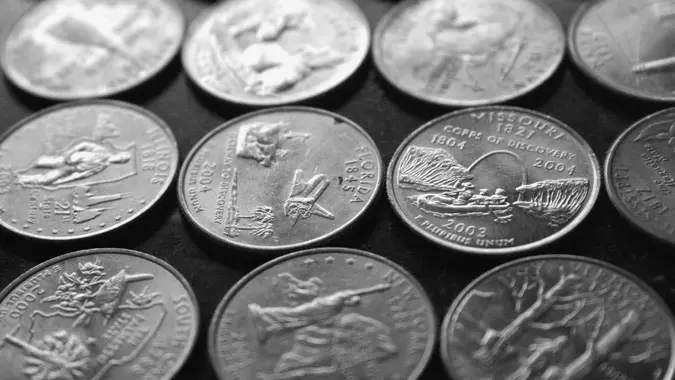5 Costly Mistakes Women Make With Their Money

Commitment to Our Readers
GOBankingRates' editorial team is committed to bringing you unbiased reviews and information. We use data-driven methodologies to evaluate financial products and services - our reviews and ratings are not influenced by advertisers. You can read more about our editorial guidelines and our products and services review methodology.

20 Years
Helping You Live Richer

Reviewed
by Experts

Trusted by
Millions of Readers
Many women are making proactive choices to better manage their money, including making smart purchases (31%), successfully managing their household’s finances (27%) and being financially independent (26%), according to a recent Fidelity study. On the other hand, women also admit to making some costly mistakes when it comes to how they handle their finances.
In this “Financially Savvy Female” column, we’re chatting with Lorna Kapusta, head of women and engagement at Fidelity, about the most common financial mistakes women make and what they can do to mitigate them.
40% of Women Are Not Saving Enough for Emergencies
According to the Fidelity study, many women lack a sufficient emergency fund — and this can be a costly mistake.
“Everyone needs emergency savings — no matter how old you are or what your income level is,” Kapusta said. “There are various circumstances that could require having cash on hand — losing a job, natural disasters, a leaky roof, unexpected child care expenses, a surprise medical bill that insurance won’t cover, or family members returning home or needing help.”
These emergencies tend to pop up more often than you would expect.
“We found that 45% of individuals who experienced a financial setback in 2023 had to dip into their emergency savings,” Kapusta said.
That’s why it’s so vital for women to be proactive about building an emergency fund.
“Planning ahead is key so any potential emergencies don’t derail your finances,” Kapusta said. “We are seeing women want to prioritize their emergency savings. In fact, contributing to emergency savings is the top action women plan to take in the next six months. And when they do, they feel less stress and greater peace of mind.”
If you’re starting from zero, Fidelity suggests building a buffer of at least $1,000.
“And if you feel you can do more, set aside three to six months’ worth of essential living expenses,” Kapusta said.
There are a couple of effective ways to boost your emergency savings, even on a tight budget:
“[One is to] think of your emergency savings fund as a bill,” Kapusta said. “With rent or mortgage payments, contributing to a retirement fund and myriad living expenses, you already have a lot to balance. But if you turn saving for emergencies into a monthly priority, you’ll get in the habit of contributing to it regularly.”
The other way is to trim spending.
“If there are any areas of your budget where you could cut back, it may be worth giving it a try — at least temporarily,” Kapusta said. “Directing some of those savings for emergencies could help bolster your emergency savings quickly.”
33% of Women Are Not Following a Budget
While the idea of a budget may not be fun, it can be vital to your financial security.
“A budget helps you understand your spending habits and moves you closer to your money goals,” Kapusta said. “Not following a budget can result in overspending, difficulty in achieving long-term financial stability and overall poor financial management. In order to make informed decisions about your finances, you need to know what’s coming in and going out every month.”
If you are new to budgeting, Kapusta recommends taking the following steps:
- Find your why: “Set one to three goals, which can help motivate you to stick to a budget.”
- Pick the right tool: “Create your own budgeting tracker or download many of the budgeting worksheets or apps available for free online.”
- Note your monthly income: “Add up your paychecks over the month and plug that into your budget. Be sure to consider taxes if they aren’t withheld for you.”
- List your monthly expenses: “Account for all your expenses — even ones you think only amount to a few dollars. If you use cash, keep your receipts. Review your credit and debit card statements, and don’t forget to account for peer-to-peer payment platforms.”
- Aim for the right allocation: “Once you’ve listed out your expenses, group them into high-level categories: essential expenses, retirement savings and short-term savings.”
- Give yourself some slack: “Avoid shooting for unrealistic spending limits or monthly savings goals. You’re more likely to be successful with subtle nudges toward better spending habits than a radical shove in a new direction. So each month, tweak your estimated spending in a category or two to save more, or direct that money toward more pressing needs.”
- Keep at it: “Track your income and expenses regularly and make adjustments as needed. And don’t forget to celebrate yourself. Whenever you hit a milestone, give yourself an extra-special treat, which can encourage you to keep going. Just make sure you budget for it.”
30% of Women Said They Didn’t Prioritize Their Finances Early Enough and 25% Said They Waited Too Long To Start Saving for Retirement
“Time is such a valuable asset when it comes to saving and investing because of compound interest and additional time to recoup any potential dips in the market,” Kapusta said. “We found that nearly 7 in 10 women said they wished they started investing their extra savings earlier. What is encouraging is that we’re seeing individuals start getting involved with their finances earlier and earlier.”
No matter where you are in life, the most important thing is to start planning for the future now.
“Think of planning for retirement as a journey,” Kapusta said. “The key is to save as much as you can now and try to increase savings over time. Fidelity recommends aiming to save 15% of income toward retirement annually, which includes any matching contributions or profit sharing an employer may make to a workplace retirement account like a 401(k) or 403(b). This can help ensure that you can maintain your lifestyle in retirement.”
It’s always best to start sooner rather than later.
“The earlier you start, the more time you have for your investments to grow — and recover from the market’s inevitable downturns,” Kapusta said. “If retirement is decades away, it may be hard to think or care about it, but when you are young is precisely the time to start saving for retirement. Even though it can be a challenge to save for the future, giving your savings those extra years to grow could make the struggle worth it. Every little bit you can save helps.”
If you feel like you’re starting from behind, there are steps you can take to catch up.
“First of all, it’s never too late to get started on your financial journey,” Kapusta said. “If you feel behind, don’t let that stop you from taking control of your finances.”
The first step you should take is to create what Kapusta calls “a money roadmap.”
“Map out your income, your expenses and your goals, both short-term and long-term,” she said. “This will help you start to develop a plan that works for you and your financial goals.”
Next, break down your financial concerns and goals into small, achievable steps.
“Don’t try tackling everything at once — Rome wasn’t built overnight,” Kapusta said. “This makes the process less overwhelming and more attainable.”
Finally, remember that you don’t have to do this alone. You can join online communities like Fidelity’s Women Talk Money, or schedule a consultation with a financial professional.
24% of Women Say They Have Accumulated Too Much ‘Bad’ Debt
While you might view having any debt as a negative, it’s important to remember that all debt is not created equal.
“Bad debt is debt used to finance purchases that won’t increase your net worth or future income,” Kapusta said. “In some cases, the debt may be used to buy things that depreciate. Bad debt often has a high interest rate now or a variable rate that could become high in the future, meaning you’ll likely end up paying a premium for purchases that are worth less over time. Some examples include credit card debt and other high-interest loans.”
If you have “bad debt,” Kapusta recommends prioritizing paying down your debts based on the interest rate.
“Fidelity recommends targeting paying off debts with interest rates of more than 6% as soon as you can,” she said. “It may seem counterintuitive not to chip away at all of your debt, but money you’d spend getting ahead on lower-interest-rate debt may be better spent on investments that historically have returned more than 6% each year on average.”
More From GOBankingRates
 Written by
Written by  Edited by
Edited by 




























